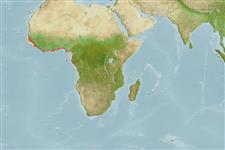>
Eupercaria/misc (Various families in series Eupercaria) >
Lutjanidae (Snappers) > Lutjaninae
Etymology: Lutjanus: Malay, ikan lutjan, name of a fish.
More on author: Bleeker.
Environment: milieu / climate zone / depth range / distribution range
Ecología
marino; salobre asociado a arrecife. Tropical; 13°N - 20°S, 21°W - 17°E (Ref. 55)
Tamaño / Peso / Age
Maturity: Lm ? range ? - ? cm
Max length : 139 cm TL macho / no sexado; (Ref. 40637); common length : 50.0 cm TL macho / no sexado; (Ref. 55); peso máximo publicado: 60.0 kg (Ref. 40637)
Espinas dorsales (total) : 10; Radios blandos dorsales (total) : 13 - 14; Espinas anales: 3; Radios blandos anales: 8. Diagnosis: head pointed; gape of mouth wide (Ref. 57393). Body relatively deep; dorsal head profile straight or somewhat concave; lachrymal bone broad (Ref. 81653). Maxilla extending nearly to mid-eye level (Ref. 55, 57393, 81653). Vomerine tooth plate triangular, sometimes with a short postero-median extension (Ref. 57393, 81653). Preopercular notch and knob weak; pectoral fins of adults not reaching level of anus (Ref. 55, 81653). Scales medium-sized; 5 or 6 transverse scale rows on cheeks (Ref. 57393, 81653). Scale rows on back parallel to lateral line (Ref. 55, 57393, 81653), 4 rows below middle of spinous part of dorsal fin (Ref. 57393, 81653). Reddish brown to slightly orange on back and upper sides, grading to pink or whitish on lower sides and belly; tips of pelvic fins very dark (Ref. 55, 57393, 81653). No blue line on cheeks (Ref. 57393, 81653). Juveniles with a series of about 6 to 8 vertical rows of small white spots or narrow bars on side (Ref. 55, 57393, 81653).
Adults inhabit rocky bottoms and (inshore) coral reefs; also common in brackish lagoons and found in lower courses of rivers, particularly juveniles (Ref. 55, 57393, 81653). Marketed fresh.
Life cycle and mating behavior
Maturities | Reproducción | Spawnings | Egg(s) | Fecundities | Larva
Allen, G.R., 1985. FAO Species Catalogue. Vol. 6. Snappers of the world. An annotated and illustrated catalogue of lutjanid species known to date. FAO Fish. Synop. 125(6):208 p. Rome: FAO. (Ref. 55)
IUCN Red List Status (Ref. 130435)
Threat to humans
Harmless
Human uses
Pesquerías: escaso valor comercial; pesca deportiva: si
Herramientas
Special reports
Download XML
Fuentes de Internet
Estimates based on models
Preferred temperature (Ref.
123201): 25.8 - 28, mean 27.5 °C (based on 153 cells).
Phylogenetic diversity index (Ref.
82804): PD
50 = 0.5000 [Uniqueness, from 0.5 = low to 2.0 = high].
Bayesian length-weight: a=0.01288 (0.00767 - 0.02165), b=2.90 (2.76 - 3.04), in cm total length, based on LWR estimates for this species & Genus-body shape (Ref.
93245).
Nivel trófico (Ref.
69278): 4.0 ±0.56 se; based on food items.
Resiliencia (Ref.
120179): Muy bajo, población duplicada en un tiempo mínimo superior a 14 años (Preliminary K or Fecundity.).
Fishing Vulnerability (Ref.
59153): Very high vulnerability (83 of 100).
Nutrients (Ref.
124155): Calcium = 16.3 [10.0, 24.2] mg/100g; Iron = 0.248 [0.157, 0.387] mg/100g; Protein = 18.9 [17.4, 20.2] %; Omega3 = 0.122 [0.086, 0.171] g/100g; Selenium = 79.4 [50.1, 122.6] μg/100g; VitaminA = 84.9 [15.3, 311.2] μg/100g; Zinc = 0.404 [0.321, 0.543] mg/100g (wet weight);
